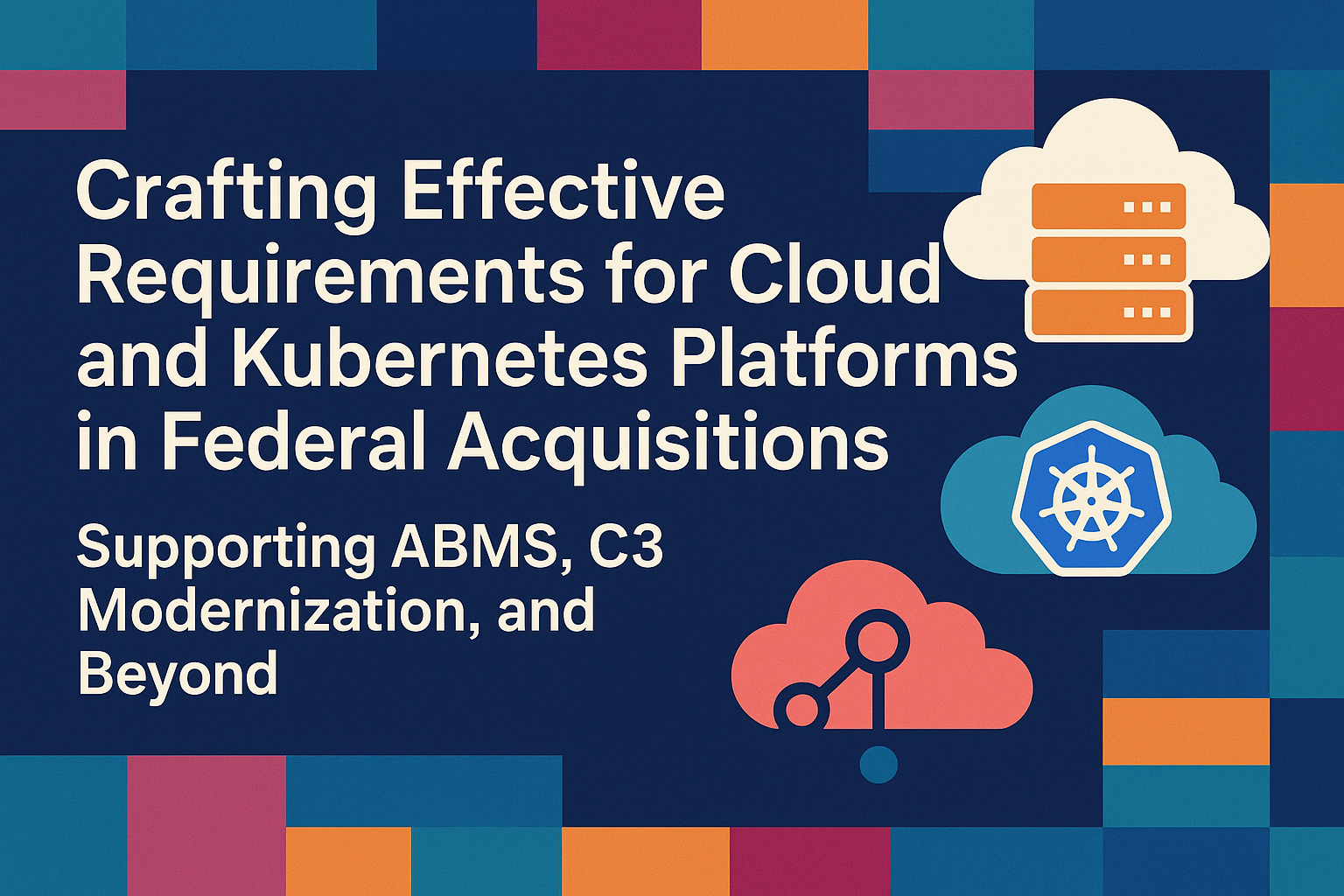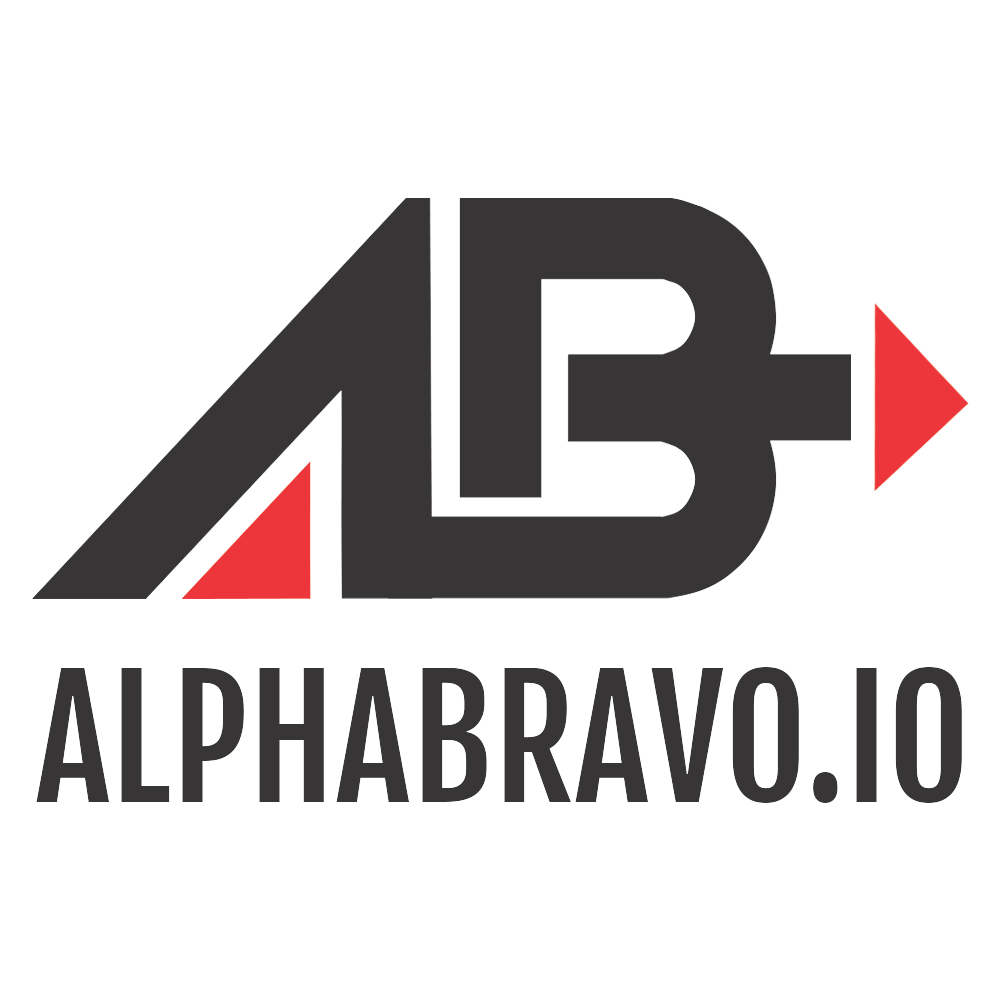Crafting Effective Requirements for Cloud and Kubernetes Platforms in Federal Acquisitions: Supporting ABMS, C3 Modernization, and Beyond
Crafting precise, mission-aligned requirements for cloud and Kubernetes platforms is the linchpin for modernizing DoD capabilities like ABMS and C3, ensuring both innovation and uncompromising security in federal acquisitions.

As the Department of Defense (DoD) embraces cloud technologies and containerization to modernize its IT infrastructure, acquisition professionals face the complex challenge of drafting requirements that balance innovation with stringent security mandates. High-profile initiatives like the Advanced Battle Management System (ABMS) and Command, Control, and Communications (C3) modernization depend on well-crafted requirements to succeed. This comprehensive guide explores how to effectively specify cloud and Kubernetes requirements in federal acquisitions while highlighting how AlphaBravo's expertise can streamline this complex process.
The Evolving Federal Cloud and Container Landscape
The DoD's digital transformation initiatives are accelerating rapidly, with cloud computing and Kubernetes-orchestrated containerization at their core. These technologies enable the speed, flexibility, and interoperability needed for next-generation defense systems, but navigating the associated requirements presents significant challenges for acquisition professionals.
Why Requirements Matter More Than Ever
Well-crafted technical requirements determine the success or failure of cloud and Kubernetes implementations in the federal space. Requirements that are too vague risk non-compliance, while overly restrictive specifications can limit innovation and competition. Finding the right balance requires deep knowledge of both federal acquisition processes and emerging technologies.
Understanding the DoD Cloud Security Framework
Impact Levels: The Foundation of DoD Cloud Requirements
The DoD classifies cloud security using Impact Levels (IL) based on data sensitivity and the potential impact of a compromise:
- Impact Level 2 (IL2): Non-controlled unclassified information
- Impact Level 4 (IL4): Controlled Unclassified Information (CUI)
- Impact Level 5 (IL5): Higher sensitivity CUI and National Security Systems
- Impact Level 6 (IL6): Classified information up to SECRET
Your requirements must explicitly state the appropriate Impact Level and ensure vendors can demonstrate the necessary authorizations and compliance.
Cloud Computing Security Requirements Guide (CC SRG)
Requirements must align with the DoD Cloud Computing Security Requirements Guide, which establishes security standards for cloud service providers (CSPs) that handle DoD data. The CC SRG builds on the FedRAMP Moderate baseline, incorporating additional DoD-specific security enhancements (FedRAMP+) to mitigate insider threats and advanced persistent threats.
Data Sovereignty Requirements
DFARS clause 252.239-7010 mandates that contractors "maintain within the United States or outlying areas all Government data that is not physically located on DoD premises, unless the Contractor receives written notification from the Contracting Officer to use another location". Your requirements must explicitly address data sovereignty concerns and establish clear boundaries for where information can be stored and processed.
Key Kubernetes Requirements for DoD Environments
Security and Compliance Integration
Kubernetes deployments in DoD environments require alignment with DISA Security Technical Implementation Guides (STIGs). These comprehensive security guidelines ensure containerized applications meet DoD security standards. Your requirements should specifically mandate STIG compliance and include validation mechanisms.
According to the Kubernetes Node STIG Automated Compliance Validation Profile: "These check results should provide information needed to receive a secure authority to operate (ATO) certification for the applicable technology". Consider requiring automated compliance validation tools in your specifications.
Trust Boundaries and Security Perimeters
Establishing clear trust boundaries in Kubernetes is essential for DoD deployments. As noted in a recent analysis of Kubernetes for DoD environments, "Trust boundaries in Kubernetes are the invisible walls between system components" that maintain security separation. Requirements should specify how these boundaries must be established and maintained.
Attribute-Based Management for Secure Cloud Bursting
For environments that may need to scale dynamically between classified and unclassified domains, consider requirements for attribute-based management. Research indicates that "combining Attribute-Based Encryption (ABE) with Kubernetes labeling" can provide "a unified management model that ensures data confidentiality while enabling efficient cloud bursting".
Supporting Major DoD Initiatives Through Effective Requirements
Advanced Battle Management System (ABMS) Considerations
ABMS is designed to allow "Air Force and Space Force systems to share data that will enable faster C2 decision making". It includes multiple components like Cloud-Based Command and Control (CBC2), Digital Infrastructure (DI), Distributed Battle Management Node (DBMN), and Aerial Networking.
When writing requirements for systems supporting ABMS, you must consider:
- Interoperability specifications - Requirements that ensure seamless data sharing across domains
- Real-time data processing capabilities - Specifications for handling the high-volume, low-latency data needs of battlefield systems
- Cloud-native application design - Requirements encouraging modern development practices that align with DoD cloud strategies
As the DoD FY2024 Annual Report on ABMS notes, "DoD military commanders use ABMS to share data and information and receive a real-time, complete picture of the battlespace so that they can quickly make informed decisions, direct action, and monitor execution of operations". Your requirements should reflect these operational needs.
C3 Modernization Requirements
The DoD Command, Control, and Communications (C3) Modernization Strategy provides approaches for modernizing C3 enabling capabilities in the 2020-2025 timeframe. This strategy "focuses on protecting and preserving current C3 capabilities; ensuring reliable U.S., ally, and key partner access to critical information at time of need; and providing seamless, resilient, and secure C3 transport infrastructure enabling a more lethal Joint Force".
Requirements supporting C3 modernization should address:
- Resilient communications infrastructure - Specifications for maintaining operations in contested environments
- Cross-domain security solutions - Requirements for secure information sharing across classification boundaries
- Electromagnetic spectrum operations - Considerations for spectrum management in cloud deployments
The C3 Modernization Strategy emphasizes that "C3 systems are fundamental to all military operations, delivering the critical information necessary to plan, coordinate, and control forces and operations across the full range of Department of Defense (DoD) missions". Your requirements should reflect this mission-critical nature.
Best Practices for Writing Cloud and Kubernetes Requirements
Functional Requirements Validation
DoD Instruction 5000.82 requires DoD Components to take full advantage of cloud services. During requirements validation, consider the following criteria:
- Functionality – Does a cloud service meet functional requirements? Understand the type of cloud service required (e.g., software as a service (SaaS), platform as a service (PaaS), or infrastructure as a service (IaaS)).
- Availability – Can the cloud service serve the operational area of need (e.g., tactical edge)?
Acquisition Planning for Cloud and Kubernetes
During acquisition planning, develop requirements that address:
- Publication of high-value data assets and all associated interfaces in DoD federated data catalogs
- Use of Application Programming Interfaces (APIs) to provide access to data assets by authorized users
- Storage of data in a platform and environment-agnostic manner, uncoupled from infrastructure dependencies
- Management of data assets that promotes enterprise interoperability
Cybersecurity Strategy Requirements
Require vendors to develop a comprehensive cybersecurity strategy that outlines plans for implementation status of projected cybersecurity activities across all phases of the digital capability's lifecycle. The strategy should be regularly updated throughout the system lifecycle in accordance with DoD Instructions 5000.90 and 8580.1.
Advanced Kubernetes Features
Consider requirements for advanced Kubernetes capabilities:
- Predictive Auto-scaling - Research shows that "machine learning based predictions" for Kubernetes auto-scaling can provide proactive provisioning rather than reactive scaling when thresholds are crossed.
- Multi-Cluster Management - Requirements for managing clusters across disparate environments, as highlighted by Red Hat Advanced Cluster Management for Kubernetes which "controls clusters and applications from a single console, with built-in security policies".
- Cloud-Native Network Functions - For telecommunications support, research demonstrates that "containerized IP Multimedia Subsystem (IMS) based on the open-source Kubernetes cloud" can recover services from failure in only 15 seconds.
How AlphaBravo Supports Federal Cloud and Kubernetes Acquisitions
AlphaBravo specializes in "Mission Ready Kubernetes For The DoD," offering solutions that align perfectly with the complex requirements of federal acquisitions. Their approach can significantly streamline the requirements development process through:
Compliance-Driven Automation
AlphaBravo provides built-in enforcement for frameworks like DISA STIGs and Zero-Trust Architecture. This capability allows acquisition professionals to confidently specify compliance requirements knowing they can be automatically validated and enforced.
Multi-Cloud and Air-Gapped Support
Federal systems often operate across multiple clouds and include air-gapped environments. AlphaBravo simplifies operations across AWS, Azure, GCP, and disconnected environments, enabling requirements writers to specify cross-cloud capabilities without limiting competition.
GitOps Workflow Integration
AlphaBravo's GitOps workflow integration enforces consistency and scalability with version-controlled, automated pipelines. This capability allows acquisition professionals to specify modern DevSecOps practices with confidence that vendors can implement them in compliance with DoD requirements.
SBOM Transparency
Software Bill of Materials (SBOM) requirements are increasingly critical for federal acquisitions. AlphaBravo generates "auditable, tamper-proof records for software supply chain security", enabling clear SBOM requirements in solicitations.
Security-First Design
AlphaBravo's "immutable infrastructure and pre-hardened containers reduce vulnerabilities and configuration drift". This approach allows acquisition professionals to specify high security standards knowing they are achievable with current technology.
Implementing Effective Requirements: A Practical Approach
Structured Requirements Development
When drafting cloud and Kubernetes requirements for federal acquisitions, consider this structured approach:
-
Categorize requirements by domain:
- Infrastructure and platform specifications
- Security and compliance mandates
- Operational capabilities and constraints
- Integration and interoperability needs
-
Use performance-based specifications where possible to encourage innovation while ensuring mission requirements are met
-
Include validation and testing requirements that clearly define how compliance will be verified
-
Address the full lifecycle including deployment, operations, and sustainment
Sample Requirement Language
Below are examples of well-structured requirements for DoD cloud and Kubernetes deployments:
Cloud Security Requirement Example:
The solution shall maintain all Government data within the United States in accordance with DFARS clause 252.239-7010, unless explicitly authorized by the Contracting Officer to use another location. The contractor shall provide documentation of compliance with DoD Cloud Computing Security Requirements Guide at Impact Level 5.
Kubernetes Management Requirement Example:
The solution shall provide centralized management of multiple Kubernetes clusters across disparate environments (cloud, on-premises, tactical edge) from a single control plane, with policy-based governance for security, applications, and infrastructure in accordance with DISA STIGs.
ABMS Support Requirement Example:
The cloud platform shall enable real-time data sharing and situational awareness compatible with ABMS requirements, including the ability to process and distribute time-sensitive targeting data with latency not exceeding 200ms.
Real-World Application Scenarios
Supporting Multi-Domain Operations
A DoD component needs to deploy applications that support C3 modernization across multiple classification domains. The requirements must address:
- Cross-domain security controls that enable limited data sharing between domains
- Consistent security policy enforcement across all environments
- Centralized monitoring and management while maintaining domain separation
AlphaBravo's multi-Kubernetes management platform ensures adoption of technologies like "Rancher, Red Hat OpenShift, or VMware Tanzu, while securely migrating from legacy systems without disrupting operations".
Edge Computing for Tactical Environments
Tactical edge computing for ABMS requires specialized cloud and Kubernetes capabilities:
- Low-bandwidth optimization for constrained network environments
- Disconnected operations for periods without connectivity
- Lightweight deployments with minimal resource requirements
AlphaBravo's solutions for "deploying lightweight updates in low-bandwidth environments to synchronizing air-gapped networks with digital twins" address these challenging requirements.
Conclusion: Navigating the Path Forward
Crafting effective requirements for cloud and Kubernetes platforms in federal acquisitions is challenging but essential for successful DoD modernization. By understanding the security frameworks, technical considerations, and program-specific needs, acquisition professionals can develop requirements that enable innovation while ensuring compliance.
AlphaBravo's specialized expertise in DoD-ready Kubernetes deployments provides a valuable resource for agencies navigating this complex landscape. Their focus on compliance automation, multi-cloud support, and security-first design aligns perfectly with the needs of federal acquisition professionals tasked with modernizing defense systems.
As the DoD continues its digital transformation journey, the partnership between knowledgeable acquisition professionals and specialized technology providers like AlphaBravo will be increasingly important. By leveraging this expertise, the federal government can accelerate adoption of cloud-native technologies while maintaining the security and reliability essential to national defense.
For more information on how AlphaBravo can support your cloud and Kubernetes requirements development, visit https://alphabravo.io or contact them at (202)420-9736.

